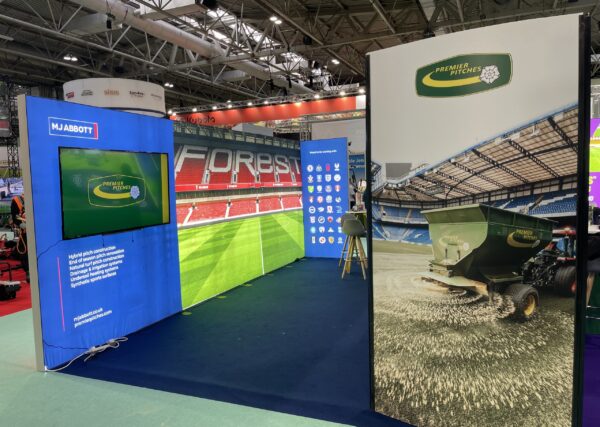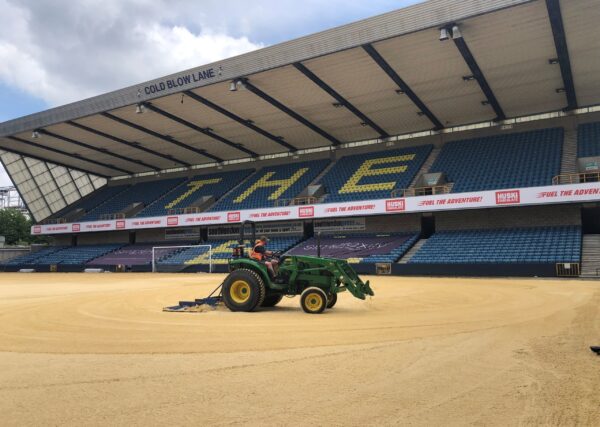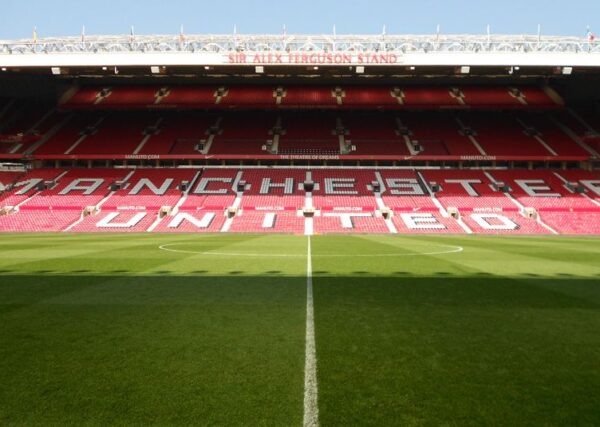Professional football pitch management is no longer about providing a surface, which will withstand the rigours of 90 minutes of football, any league groundsman will testify to this. Groundsmen now have the additional pressure of providing a surface that will be used for a pre match warm up which can last up to 30minutes. There are also half time activities including penalty shootouts, marching bands, dancers, and junior matches played across the pitch. If all this is not enough teams now insist on a warm down after the match which in many cases becomes a full blown training session for squad players not involved in the 90 minutes of action which has just gone. Success in European competitions brings additional burdens as travelling teams have access to the match pitch for training sessions on the day prior to the European tie being played. Other activities such as concerts etc. bring in much needed revenue to clubs who are in the business of making money by what ever means, to support their main objective which is to be successful on the pitch.
These activities are undertaken often in stadiums which have either evolved or worse still have been designed with no thought to the well being of the pitch, which at the end of the day is the one thing that is required for these activities to take place.
One answer to relieve the pressure facing stadium groundsmen would be to persuade clubs that the pitch should only be used for the duration of matches as they were in the past, this may have been voiced by individuals at some stage, I can imagine the answer from club officials. We as grounds managers must come to terms with the fact that this additional pressure will not go away. As unnecessary as it may appear to some, activities such as warm down sessions are undertaken for a reason and have evolved as part of a greater understanding of the requirements to produce a superior level of skill and fitness. As a consequence of this greater understanding we now see players performing at a much higher level when we watch a game of football.
So where does this leave the person entrusted with producing a surface, which will cater for all the needs of a club?
It is my view that we must take a positive attitude with regard to the situation. Things will not change, clubs will not reduce the height of stands to reduce the impact of shade, nor will they open up corners of the stadium to allow more air movement or reduce the amount of additional activity on the pitch during match days and in the close season.
Stadium pitches generally have improved tremendously over the last ten years, which is a credit to all involved from Groundsmen to researchers and manufacturers. Groundsmen now face a new challenge involving the additional pressures mentioned above. Problems with weather during the winter months are well documented and this has been addressed by most clubs who now have efficient drainage systems that will remove large amounts of water effectively so that they have a reasonable playing surface which will withstand 90 minutes of football. Will this surface withstand the new set of problems placed upon it?
Although I do not pretend to hold all the answers to these increasing burdens I am, in this article, trying to formulate a plan of action that will go some way to producing a pitch able to withstand the new challenges posed by increased usage and stadium problems.
In my view one thing that contributes to the solution is a clean open sward clear of Poa Annua. A thick dense sward is often viewed by many as an essential component when producing winter games pitches, however I would argue that a thick dense sward creates its own set of problems as the majority of pitches which appear to have a dense sward are dominated by Poa Annua which produces thatch.
To attempt to create a suitable playing surface the following problems must be looked at in detail –
Problem – Surface divots, thatch and surface stability.
Firstly what is a divot and how does divotting occur?
Divots are produced when a players boot makes moving contact with the surface of the pitch, separating the grass plant and accumulated thatch from the root zone leaving an area devoid of grass cover. Divots can be replaced to cover the exposed area but in the winter months the roots will not regrow and the cycle repeats itself. If a sward is open and supporting healthy Rye Grass plants without thatch, divots to a large extent cannot occur. The grass will only scar, meaning that the grass is moved within the rootzone rather than removed. Scarring can be repaired as the root is still intact and will recover more effectively.
Surface stability is often affected on a thatchy pitch by the addition of bulky top dressings such as sand and root zone. When it is applied in the close season the top dressing just sits on the top of the thatch rather than integrating into the rootzone, causing instability. To solve this the thatch must be removed prior to the application of the bulky top dressing.
Problem – Regeneration in shade and lack of atmospheric air movement.
The impact of shade and impeded air circulation will affect the characteristics of a pitch. Higher stands and wrap around stadiums will severely impede the ingress of vital air and light, as a consequence grass will struggle to grow. Regeneration will be even more hampered if the small amounts of light and air present can not be absorbed by the plant due to thatch accumulation.
Problem – Migration of fines within the root zone, black layer, irrigation and nutrition.
Over time some pitches will inevitably suffer from finer particles within the root zone migrating to the surface, this impedes drainage rates and can lead to layering within the rootzone which affects surface stability and causes shallow rooting.
Anaerobic black layer is associated with stadium pitch problems it can be problematic in even the best maintained pitches. This can be kept at bay by regular aeration practices being undertaken at the correct time of year.
Finally the nutrition and irrigation which is required to produce the desired playing surface can often be inappropriately administered. Players, managers and club officials all wish to see a pitch, which is green and well presented, this sometimes puts pressure on the groundsman to over fertilise and water. Poa dominant pitches will look impressive in the early part of the season with their thick lush sward, unfortunately when it comes to the depths of winter they often fail to live up to expectations.
There are many factors to take into account, however if a pitch made up of an open Rye Grass sward, free of thatch and Poa Annua, growing in a suitable root zone, can be established then a number of the aforementioned problems will be eradicated.
How is such a pitch produced?
In agriculture farmers have for centuries cultivated land as part of its on going management. Surface cultivation by whatever form stirs up the soil, decompacts, aerates and refreshes the soil. Often this management is undertaken in a cyclical pattern between crops, this cycle of cultivation keeps the land conditioned and able to sustain whatever crop is to be grown. The “crop” sports turf managers produce is obviously grass.
Historically managers of sports turf pitches have not had the opportunity to undertake surface cultivation mainly because of the cost involved in removing the existing sward and the fear of insufficient recovery time due to playing seasons starting earlier and finishing later. Subsequently sub surface cultivation has been the only option available to aerate and decompact. All practices associated with sub surface cultivation are designed to minimise disturbance to the existing sward. We now however have the ability to remove existing swards efficiently and economically by employing the Koro Field Top Maker.
Surface cultivation is based on the assumption that, a reasonable root zone exists with the ability to sustain healthy growth and remove precipitation efficiently. Prior to any surface cultivation pitches must be evaluated it should not be assumed that surface cultivation is suitable for all pitches, for example your pitch may have a bypass drainage system which could be damaged by surface cultivation, however in this instance thatch and Poa Annua can still be removed by the Koro Field Top Maker and the Koro Recycling Dresser can also be used without disruption to the bypass drainage system.
My suggested plan of action is centred around a cyclical programme and as such would commence in the close season by using the Koro Field Top Maker to remove all existing accumulations of herbage and thatch (removal of the top should not be confused with fraise mowing). Cultivation would then be necessary to redistribute any fines, which may have worked their way to the surface. Air will be introduced to the profile of the root zone by cultivation; any problems associated with anaerobic conditions such as black layer will be addressed at this stage. During cultivation soil conditioners such as seaweed meal etc can be added, as they will be well integrated into the root zone. An opportunity also exists to introduce fibre stabilisation, which will enhance the playing characteristics by reinforcing the root zone. Fibre stabilisation is the ideal method for this system as it will benefit from periodic surface cultivation and remain unaffected through out the cycle of operations. Once this work has been completed the pitch may be levelled to an acceptable standard. Overseeding using suitable equipment should follow using only Dwarf Perennial Ryegrass seed sown at the recommended rate, do not fall into the trap of adding three or four bags for luck and one more for the pigeons. Pre-seeder fertiliser should then be applied in accordance with soil analysis.
Once the sward starts to establish correct management practices can be undertaken such as irrigation, aeration, fertilisation etc. These practices should be carried out for the purpose of producing a healthy deep-rooted sward able to withstand the rigours of the season to come. During the first season the pitch should perform well given the correct management. At the end of the season hopefully the pitch will have coped with the increased demands far better than it may have done previously due to the removal of thatch forming Poa Annua.
To prevent the re-formation of Poa Annua, during the close season in the second year it will again be necessary to employ the Koro Field Top Maker. This time the machine should be used to fraise mow the pitch. This operation will clear out any unwanted organic accumulations and grub out Poa Annua colonies. Perennial Rye Grass plants will remain largely unaffected by this operation and will regenerate within a short period of time. If appropriate the Koro Recycling Dresser can be used to good effect, this machine will aerate decompact and provide a source of top dressing all in one pass.
At this stage any necessary bulky top dressing operations can be undertaken such as sand application, prior to Verti-Draining/solid tining, with the confidence that they will be integrated into the root zone rather than sitting on top of an organic layer. Overseeding at the recommended rate should follow, the seed will reap the benefit of having excellent contact with the soil thus making germination and subsequent establishment far superior to seed sown into a thatch layer.
As the second season approaches it will become crucial that attention is given to aeration throughout the growing season to minimise the occurrence of anaerobic conditions. Although the Koro Field Top Maker will have thoroughly cleaned the surface one can not afford to be complacent and as such scarification and verti-cutting will be necessary to keep the sward open and free of any unwanted organic build up which may affect the performance characteristics of the pitch. Verti-cutting will also assist in preventing the sward from becoming woolly, which could lead to disease infestations etc.
A close inspection and evaluation will be required towards the end of the second season. If the pitch is in a similar condition to last year it may be that a repeat of operation undertaken during the end of the first season will suffice to see the pitch through to the end of the third season. If this is the case all well and good, a little adjustment to renovation may be necessary to redress any small problems, if the Koro Recycling Dresser was not used last season it may well be worth using it this close season. On the other hand if it appears that problems are reoccuring (which may happen in certain Stadiums) to such a degree that it will affect the development of a clean open sward then the work prescribed for the first season can be undertaken again.
This system of pitch management is intended to reduce many of the factors that can be attributed to stadium pitch problems. Due to the availability of new machinery handled by competent operators, surface cultivation and other operations can be undertaken cost effectively and when necessary thus eliminating the need for costly removal and replacement of the rootzone.
Related news
Saltex 2024
Saltex 2024 We can’t wait to reconnect with our customers, suppliers, and industry friends at Saltex later this month! This event serves as a ...
Pitches – Why Clubs Should Prepare Rather Than Repair
Professional football pitch management is no longer about providing a surface which will withstand the rigours of 90 minutes of football, any league ...
Associate Articles
News Release by Campey Turf published 1st July 2010 'Best ever' renovation results achieved at Manchester United's Trafford Training Centre Joe ...




